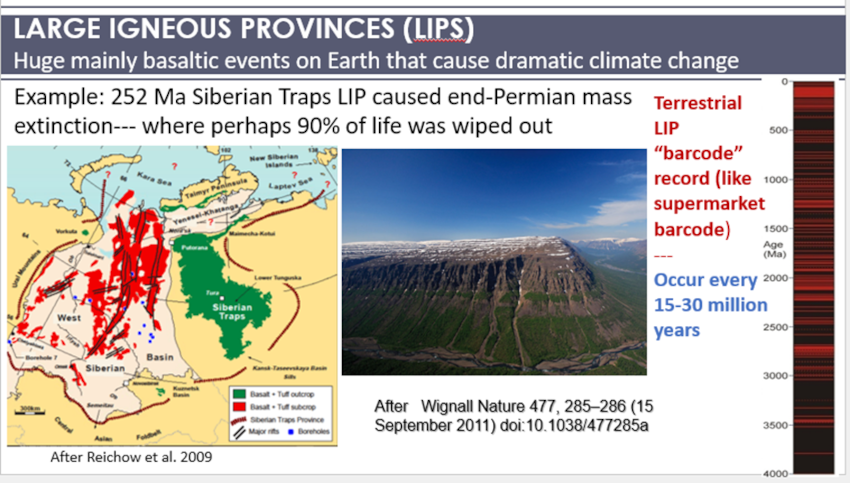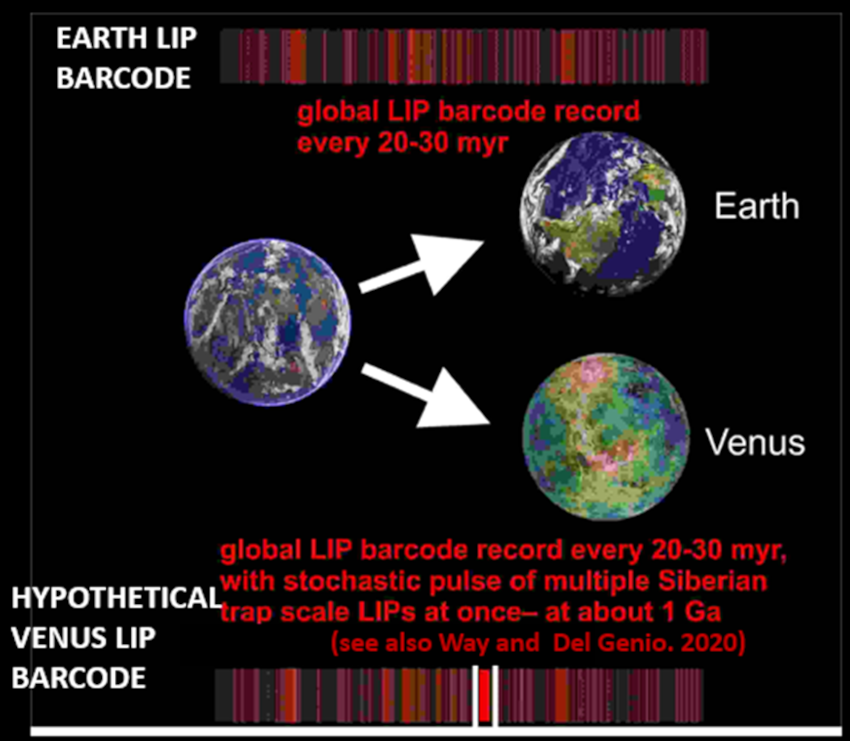November 2021 LIP of the Month
The Potential Role of Large Igneous Provinces in the Great Climate Transition on Venus
M.J. Way1,2,3, R. Ernst4,5, Jeffrey D. Scargle6
1NASA Goddard Institute for Space Studies, 2880 Broadway, New York, New York, 10025, USA
2GSFC Sellers Exoplanet Environments Collaboration
3Theoretical Astrophysics, Department of Physics and Astronomy, Uppsala University, Uppsala, SE-75120, Sweden
4Department of Earth Sciences, Carleton University, Ottawa, Canada K1S 5B6
5Faculty of Geology and Geography, Tomsk State University, Tomsk, Russia
6Astrobiology and Space Science Division, NASA Ames Research Center, MS 245, Moffett Field, USA
Earth’s sister planet, Venus, has elevated temperatures of 450C, a dense atmosphere (90 times as dense as Earth’s) which is dominated by CO2 (96%) and the absence of plate tectonics and no significant erosion. However, recent modelling (Way et al. 2016; Way and Del Genio, 2020) has indicated that the climate on Venus could have been more habitable (with a water cycle and possible plate tectonics) through most of Venus’ history with the transition into the current inhospitable conditions having occurred about 1000-700 Myr ago. There is also evidence for this Great Climate Transition preserved in the stratigraphically oldest geologically rocks, termed tesserae. Curved lineament patterns associated with corresponding topographic changes are consistent with exposure through erosion of sub-horizontally layered units such as flood basalts or even sedimentary rocks (Byrne et al. 2021) and there are paleo-valleys (highlighted by younger lava flooding) which have patterns similar to terrestrial river systems, suggesting formation by fluvial erosion (Khawja et al. 2020).
Various models have been proposed for Venus’ Great Climate Transition, and here we consider the potential role of Large Igneous Provinces (LIPs) in causing this transition (Way et al. 2021; Way et al. in prep.).
On Earth LIPs are large volume (>100,000 cu. km), often short duration, mainly mafic magmatic events that occur at a frequency (combined continental and oceanic) of one approximately 20 myr (Ernst 2014). LIPs have an origin that is distinct from normal plate boundary processes (Coffin and Eldholm 1994; Ernst 2014), and are linked to intraplate processes. An upwelling mantle plume is typically invoked, but other origins have been proposed (Campbell 2007; Foulger 2007; Ernst, 2014).
LIPs are also inferred to be common on Venus. Venus lacks plate tectonics and therefore all magmatism is by definition intraplate. The largest intraplate events are considered LIP analogues (Head and Coffin 1997; Hanson 2007; Ernst et al. 2007, 2017). Venusian LIP components include large shield volcanoes and coronae, lava flow fields, and plains volcanism and also large radiating and circumferential graben systems (interpreted to overlie dyke swarms). The rate of LIP volcanism is uncertain on Venus given the absence of direct age dating and the uncertainties associated with developing a chronology based on relative ages determined from cross cutting relationships. However, given the similar size and internal structure of Venus to Earth, we provisionally apply the terrestrial rate of LIPs (one per 20 myr) to Venus.
On Earth, LIPs are increasingly recognized as a key driver of environmental and biotic change including mass extinction events (Clapham and Renne, 2019; Ernst et al. 2021 and publications and references therein) through a variety of mechanisms: but most notably CO2 release and associated global warming. The most significant mass extinction, at the 252 Ma Permian Triassic boundary, coincides precisely with the Siberian Traps LIP event (Figure 1) and there is consensus that this LIP was responsible for this mass extinction (Burgess et al. 2015) and was associated with a large temperature increase that may have reached a global average of 40C (Sun et al. 2012; Scotese et al. 2021).
There are various causes proposed for the origin of runaway global warming on Venus, including the role of LIPs (e.g. Way and Del Genio, 2020). We evaluate whether the proposed Great Climate Transition on Venus, from habitable to present day hyper-warm with high CO2, may be associated with stochastic overlap of multiple LIPs leading to extreme runaway greenhouse conditions (Way et al. 2021; Way et al. in prep.).
If LIPs were responsible for the Great Climate Transition on Venus, then we might also speculate whether such superimposed LIP events and resulting catastrophic climate change could occur in Earth’s future, in 10s to 100s of myr (Fig. 2).

Figure 1. Distribution of Siberian Traps LIP (after Reichow et al. 2009) and image of the Putorana plateau (after Wignall 2011). Global LIPs barcode (on right) updated after Ernst 2014).

Figure 2. Potential for a transition to Venus like atmospheric conditions some time in Earth’s future.
Reference
Burgess, S.D. & Bowring, S.A. (2015). High-precision geochronology confirms voluminous magmatism before, during and after Earth's most severe extinction. Sci. Adv. 1 (7), e1500470. http://dx.doi.org/10.1126/sciadv.1500470
Byrne, P., Ghail, R., Gilmore, M., Sengör, A.M.C., Klimczak, C., Senske, D., Whitten, J., Khawja, S., Ernst, R., Solomon, S. (2021). Venus tesserae feature layered, folded, and eroded rocks. Geology, v. 49, p. 81–85.
Campbell, I.H. (2007). Testing the plume theory. Chemical Geology, 241: 153–176.
Clapham, M.E., Renne, P.R., 2019. Flood Basalts and Mass Extinctions. Annual Review of Earth Planetary Sciences 47, 275–303. https://doi.org/10.1146/annurev-earth-053018-060136.
Ernst, R.E. (2014) Large Igneous Provinces. Cambridge U. Press,
Ernst, R.E. (2020) Venus was once more Earth-like, but climate change made it uninhabitable. The Conversation (posted Dec 13, 2020). https://theconversation.com/venus-was-once-more-earth-like-but-climate-change-made-it-uninhabitable-150445
Ernst, R.E., Buchan, K.L., & Desnoyers, D.W. (2007). Plumes and plume clusters on Earth and Venus: evidence from large igneous provinces (LIPs). In Yuen, D.A., Maruyama, S., Karato, S.-i., & Windley, B.F. (eds.), Superplumes: Beyond Plate Tectonics. Springer-Verlag, pp. 537–562.
Ernst, R.E., Buchan, K.L., Jowitt, S.M., Youbi, N., 2017. Applying the terrestrial Large Igneous Province (LIPs) context to planetary intraplate magmatism. Lunar and Planetary Science Conference XLVIII, abstract 1373.
Ernst, R.E., Dickson, A., Bekker, A. (eds.) (2021). Large Igneous Provinces: A Driver of Global Environmental and Biotic Changes. American Geophysical Union Geophysical Monograph 255, 508 p., https://agupubs.onlinelibrary.wiley.com/doi/book/10.1002/9781119507444
Foulger, G.R. (2007). The “plate” model for the genesis of melting anomalies. In Foulger, G.R. & Jurdy, D.M. (eds.), Plates, Plumes, and Planetary Processes. Boulder, CO: Geological Society of America Special Paper 430, pp. 1–28.
Head, J.W. & Coffin, M.F. (1997). Large Igneous Provinces: a planetary perspective. AGU Geophysical Monograph, 100: 411–438.
Hansen, V.L. (2007). LIPs on Venus. Chemical Geology, 241: 354–374.
Khawja, S., Ernst, R.E., Samson, C., Byrne, P.K., Ghail, R.C., MacLellan, L. (2020). Tesserae on Venus may preserve evidence of fluvial erosion. Nature Communications, 11, article no 5789. https://doi.org/10.1038/s41467-020-19336-1
Reichow, M.K., Pringle, M.S., Al’Mukhamedov, A.I., et al. (2009) The timing and extent of the eruption of the Siberian Traps large igneous province: implications for the end-Permian environmental crisis. Earth and Planetary Science Letters, 277: 9–20.
Scotese, C.R., Song, H-J., Mills, B.J.W., van der Meer, D.G. (2021) Phanerozoic paleotemperatures: The earth’s changing climate during the last 540 million years. Earth-Science Reviews, v. 215, no. 103503
Sun, Y., Joachimski, M.M., Wignall, P.B., Yan, C., Chen, Y., Jiang, H., Wang, L., Lai, X., (2012). Lethally Hot Temperatures During the Early Triassic Greenhouse. Science 338, 366–370.
Way, M. J. et al. (2016) Was Venus the first habitable world of our solar system? Geophys. Res. Lett. 43, 8376–8383 (2016).
Way, M. J. & Del Genio, A. D. 2020 Venusian habitable climate scenarios: modeling Venus through time and applications to slowly rotating Venus-like exoplanets. JGR Planets 125, e2019JE006276.
Way, M.J., Ernst, R.E., Scargle, J.D. (2021). Can large scale volcanism explain the heat-death of Venus like worlds? P42B-01 AGU Fall Meeting, New Orleans, USA and online everywhere, 13-17 December.
Way, M.J., Ernst, R.E., Scargle, J.D. (in prep.). Can large scale volcanism explain the heat-death of Venus like worlds?
Wignall, P.B. (2011) Lethal volcanism. Nature News and Views, v. 477, p. 285-286.
